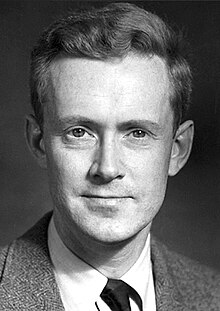Edward Mills Purcell
Edward Mills Purcell (born August 30, 1912 in Taylorville , Illinois , † March 7, 1997 in Cambridge , Massachusetts ) was an American physicist and Nobel Prize winner.
Life
Purcell studied at Purdue University (bachelor's degree in electrical engineering in 1933) and Harvard University , where he made his master's degree in 1935 and received his doctorate in 1938. He was then from 1941 to 1946 at the Radiation Laboratory of the Massachusetts Institute of Technology and from 1938 first instructor at Harvard and from 1949 professor of physics (and 1950 to 1971 senior fellow at the university). From 1980 he was Professor Emeritus there.
Purcell discovered nuclear magnetic resonance (NMR) in 1945 , and independently of it, Felix Bloch at about the same time . This discovery formed the basis for the development of nuclear magnetic resonance spectroscopy (NMR spectroscopy). B. the structure of molecules can be examined and is widely used in natural sciences and medicine (e.g. magnetic resonance imaging ). Purcell is known in this context for the so-called Carr-Purcell pulse sequence developed by him together with Herman Y. Carr (1924-2008) . Purcell was elected to the American Academy of Arts and Sciences in 1950, the National Academy of Sciences in 1951, and the American Philosophical Society in 1954 .
In 1951, together with Harold Irving Ewen and Gart Westerhout, he discovered the emission of the frequency of 1.42 gigahertz (the 21-centimeter line ) of atomic hydrogen in the Milky Way , which is caused by the change in the orientation of the electron spin relative to the nuclear spin . It was theoretically predicted in 1944 by Hendrik Christoffel van de Hulst .
The 21-centimeter line is practically undetectable in the laboratory, but is emitted in space by highly diluted interstellar gas with sufficient strength and can be detected with sensitive antennas on earth (→ radio astronomy ). Purcell and Norman Ramsey were the first to question the (now refuted) CP symmetry .
In 1951 he and Robert Pound proposed an experiment to generate negative temperatures (via a population inversion). This suggestion influenced Charles Townes' ideas about the development of measles .
In 1952 he and Felix Bloch received the Nobel Prize in Physics for their work on NMR . In 1967 he received the Oersted Medal . In 1984 he received the Max Delbruck Prize in Biophysics.
Works
- EM Purcell, HC Torrey and RV Pound : Resonance absorption by nuclear magnetic moments in a solid . In: Physical Review . Volume 69, 1946, p. 37
- Electricity and magnetism . 4th edition, Springer Verlag, 1989, Berkeley Physics Course Volume 2, ISBN 3-540-41571-8
- Life at low Reynolds number . In: American Journal of physics . 1977 (how hydrodynamics affect the life of bacteria, etc.)
Web links
- Information from the Nobel Foundation on the 1952 award ceremony for Edward Mills Purcell
- Edward M. Purcell. In: Physics History Network. American Institute of Physics
Individual evidence
- ^ Member History: Edward M. Purcell. American Philosophical Society, accessed November 4, 2018 .
- ^ Pound, Purcell A Nuclear Spin System at Negative Temperature , Physical Review, Vol. 81, 1951, pp. 279-280.
- ^ RV Pound in the Obituary to Purcell, Biographical Memoirs National Academy of Sciences
| personal data | |
|---|---|
| SURNAME | Purcell, Edward Mills |
| BRIEF DESCRIPTION | American physicist |
| DATE OF BIRTH | August 30, 1912 |
| PLACE OF BIRTH | Taylorville , Illinois |
| DATE OF DEATH | March 7, 1997 |
| Place of death | Cambridge , Massachusetts |
